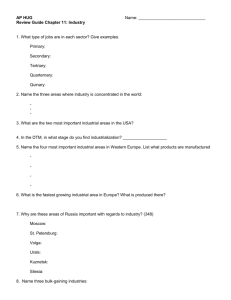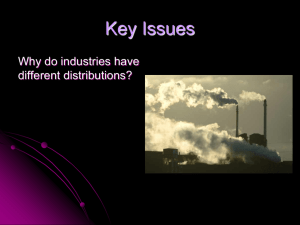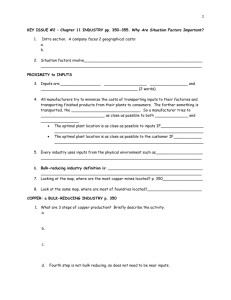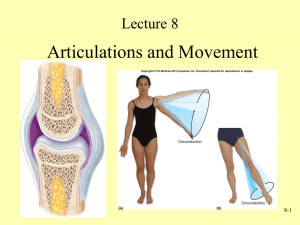Industrial Location
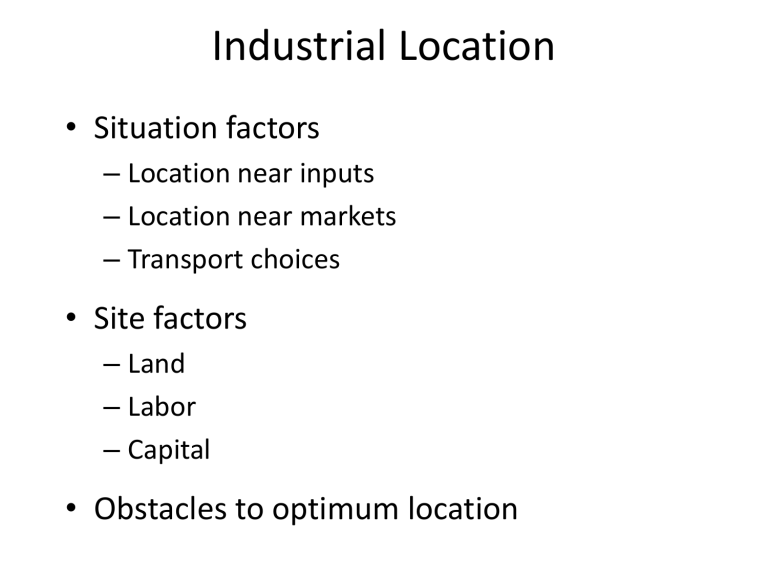
Industrial Location
•
Situation factors
– Location near inputs
– Location near markets
– Transport choices
•
Site factors
– Land
– Labor
– Capital
•
Obstacles to optimum location
Situation Factors
• A manufacturer tries to locate its factory as close as possible to both buyers and sellers.
• If the cost of transporting the product exceeds the cost of transporting inputs, then optimal plant location is as close as possible to the customer.
• Conversely, if inputs are more expensive to transport, a factory should locate near the source of inputs.
If the weight and bulk of any one input is particularly great, the firm may locate near the source of that input to minimize transportation cost.
Copper Industry in North America
Fig. 11-9: Copper mining, concentration, smelting, and refining are examples of bulk-reducing industries. Many are located near the copper mines in Arizona.
Integrated Steel Mills
Fig. 11-10: Integrated steel mills in the U.S. are clustered near the southern Great Lakes, which helped minimize transport costs of heavy raw materials.
Steel Minimills
Fig. 11-11: Minimills produce steel from scrap metal, and they are distributed around the country near local markets. These are the two largest minimill operators.
Location near Markets
The cost of transporting goods to consumers is a critical locational factor for three types of industries:bulk-gaining, single-market, and perishable.
Bulk-gaining Industries
• A bulk-gaining industry makes something that gains volume or weight during production.
• Soft-drink bottling is a good example.
• Major soft-drink companies like
Coca-Cola and Pepsi-co manufacture syrups according to proprietary recipes and ship them to bottlers in hundreds of communities.
• Because water is available where people live, bottlers can minimize costs by producing soft drinks near their consumers instead of shipping water (their heaviest input) long distances.
Location of Beer Breweries
Fig. 11-12: Beer brewing is a bulk-gaining industry that needs to be located near consumers. Breweries of the two largest brewers are located near major population centers.
Other Bulk-Gaining Industries
• More commonly, bulkgaining industries manufacture products that gain volume rather than weight.
• Common fabricated products include televisions, refrigerators, and motor vehicles.
• If the fabricated product occupies a much larger volume than its individual parts, then the cost of shipping the final product to consumers is likely to be a critical factor.
Chevrolet Assembly Plants, 1955
Fig. 11-13a: In 1955, GM assembled identical Chevrolets at ten final assembly plants located near major population centers.
Chevrolet Assembly Plants, 2003
Fig. 11-13b: In 2003, GM was producing a wider variety of vehicles, and production of various models was spread through the middle of the country.
Site Selection for Saturn
Fig. 11-1.1: GM considered a variety of economic and geographic factors when it searched for a site for producing the new Saturn in 1985. The plant was eventually located in Spring Hill, TN.
Single-Market Manufacturers
• Single-market manufacturers make products sold primarily in one location, so they also cluster near their markets.
• For example, several times a year, buyers come to New York from all over the United States to select high-style apparel.
• Manufacturers of fashion clothing then receive large orders for certain garments to be delivered in a short time.
• Consequently, high-style clothing manufacturers concentrate around New York.
• Manufacturers in turn demand rapid delivery of specialized components, such as clasps, clips, pins, and zippers.
• The specialized component manufacturers, therefore, also concentrate in New
Motor Vehicle Parts Plants
Fig. 11-14: U.S.-owned parts plants are clustered near the main final assembly plants.
Foreign-owned plants tend to be located further south, where labor unions are weaker.
Perishable Products
• To deliver their products to consumers as rapidly as possible, perishable-product industries must be located near their markets.
• Processors of fresh food into frozen, canned, and preserved products can locate far from their customers.
• The daily newspaper is an example of a product other than food that is highly perishable because it contains dated information.
• In European countries, national newspapers are printed in the largest city during the evening and delivered by train throughout the country overnight.
• Until recently, publishers considered the
United States to be too large to make a national newspaper feasible.
• With satellite technology, however, The
New York Times, Wall Street Journal, and
USA Today have moved in the direction of national delivery.
